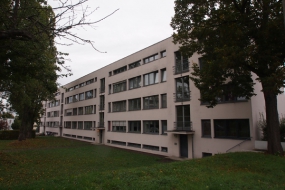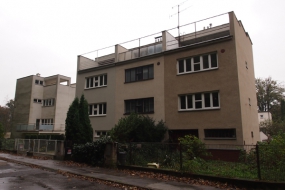Dagmar Černoušková, Iveta Černá, Stuttgart 1927 – Brno 1928 / Weissenhof and Nový dům housing estates. Inspiration also for the Villa Tugendhat? In: Radana Červená (ed.), ARCHIVUM AMICUS HISTORICI EST. A Bulleting on the occasion of Hana Jordánková’s jubilee; Brno: Archiv města Brna 2015, s. 506–599
In 1927, the German Werkbund (German Artists Association) organized a generously conceived exhibition, which, under the programmatic title "A Flat", presented ideas about 20th century construction of individual and collective housing. Seventeen architects representing European avant-garde implemented their designs. Ludwig Mies van der Rohe was the author of the housing estate plan and of the largest residential block.
In 1969, visiting her native Brno, Grete Tugendhat recalled that the Weissenhof estate had strongly impressed her. Mies visited Brno in September 1928 and it is possible that while accompanied by his hosts, he saw the exhibition of modern housing – the "New House" estate. It was part of the Exhibition of Contemporary Culture at the newly built Exhibition Centre.
Both of these exhibitions now belong to the manifesto of European modernism of the 20th century. However, they differed in two fundamental respects: 1) Stuttgart was about individual but also collective housing, with an international participation of architects; Brno was solely focused on individual housing with the participation of only domestic architects; 2) while the construction of Weissenhof was realized by the German Werkbund and the City of Stuttgart, Brno was purely a development of a private company construction company under the formal auspices of the Czechoslovak Artists Union.
In both cases it was a demonstration of modern housing for the middle class and both exhibitions have become a valuable inspiration also for the generously designed family home of wealthy clients, which later became famous as one of the most significant villa buildings in the world.
The article can be downloaded on the Czech version of our web pages.



